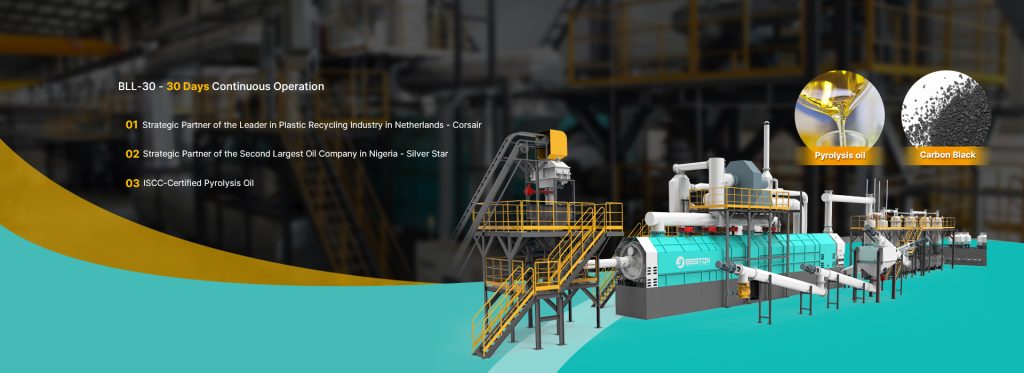When it comes to categorizing a Beston pyrolysis plant, one of the primary dimensions is the type of feedstock it is designed to process. Pyrolysis is a versatile thermal decomposition technology that can handle a variety of waste materials. The most common feedstocks include waste tires, plastic, rubber, sludge, and even biomass like coconut shells and wood chips.
A plastic pyrolysis plant, for instance, is engineered specifically for plastic waste. This type of equipment can convert PE, PP, PS, and other polymers into valuable pyrolysis oil, carbon black, and combustible gas. Each feedstock presents unique thermal and chemical challenges, so the plant configuration often varies significantly based on this input.
By Output Capacity
Output capacity is a straightforward yet vital classification. Beston Group offers pyrolysis plants in a range of capacities, typically measured in tons of waste processed per day. Small-scale systems handle around 1-5 tons daily, suitable for research, pilot projects, or niche applications.
Medium and large-scale facilities process anywhere from 10 to 30 tons or more daily and are designed for industrial-level operations. Choosing the right capacity is essential for matching operational goals and investment returns.
By Automation Level
Another crucial classification factor is the automation level of the plant. Beston offers batch-type, and fully continuous systems, each catering to different operational scales and business models. Batch systems require manual loading and unloading, making them suitable for small-scale operations or for facilities with limited labor resources.
On the other end of the spectrum, a continuous plastic pyrolysis plant is built for 24/7 operation. These systems include automated feeding, continuous discharge, and centralized control systems, providing greater efficiency and reduced downtime. The choice between batch and continuous systems depends on budget, available manpower, and desired output volume.
By End Product Utilization
Classifying pyrolysis plants by the end use of their products offers another useful lens. The three primary outputs are pyrolysis oil, carbon black, and syngas. Each of these products can be refined or utilized in different ways depending on the market demand and local infrastructure.
Some facilities are optimized for maximum oil recovery, which is then used for industrial heating or refined into diesel. Others may focus on high-quality carbon black production for use in manufacturing or rubber reinforcement. This classification helps industries tailor the system to their specific revenue models.

By Geographic Suitability
Geography plays a surprisingly influential role in plant classification. Local climate conditions, energy costs, labor availability, and waste composition all contribute to how a pyrolysis plant should be designed. For example, plants installed in colder regions might require enhanced insulation and additional pre-heating units.
Similarly, in regions where electricity is costly or unstable, diesel-powered auxiliary equipment may be favored over electric alternatives. Geographic customization is one of Beston Group’s specialties, ensuring the equipment is suited for both environmental and economic sustainability in diverse markets.
By Energy Integration
One of the more advanced classification dimensions involves the energy integration of the plant. Some facilities are designed as self-sufficient systems where the combustible gas produced during pyrolysis is captured and used to fuel the reactor itself. This reduces external energy demand and operating costs.
Energy-integrated systems can also feed excess electricity back into the grid, making them a part of larger sustainable infrastructure. This classification is gaining traction as more businesses aim to align with circular economy principles and reduce carbon footprints.
By Environmental Control Features
Environmental compliance is a growing concern for industrial plants worldwide. Beston pyrolysis plant can be classified based on their emissions control technologies. Advanced models come with integrated flue gas purification systems, desulfurization units, and activated carbon filters to meet stringent environmental regulations.
Water treatment and solid waste handling are also part of this classification. Plants that meet international environmental standards are often more desirable in regions with strict compliance requirements, making this a crucial classification for multinational operations.
By Compliance and Certification
Finally, classification by compliance and certification is critical, especially for international deployment. Beston’s plants can meet CE, ISO, and SGS standards, depending on client requirements. These certifications not only ensure equipment quality but also facilitate easier export, installation, and operational approval.
Many government tenders or corporate partnerships mandate specific certifications, making this dimension essential for commercial scaling. A compliant plant is often seen as a lower-risk investment, especially in environmentally sensitive markets.
In conclusion, understanding the classification dimensions of Beston pyrolysis plants is essential for businesses, investors, and engineers seeking optimal solutions in waste-to-energy technologies. Whether your priority is capacity, automation, environmental compliance, or product recovery, Beston’s modular approach allows for tailored systems that meet diverse industrial and regulatory needs.